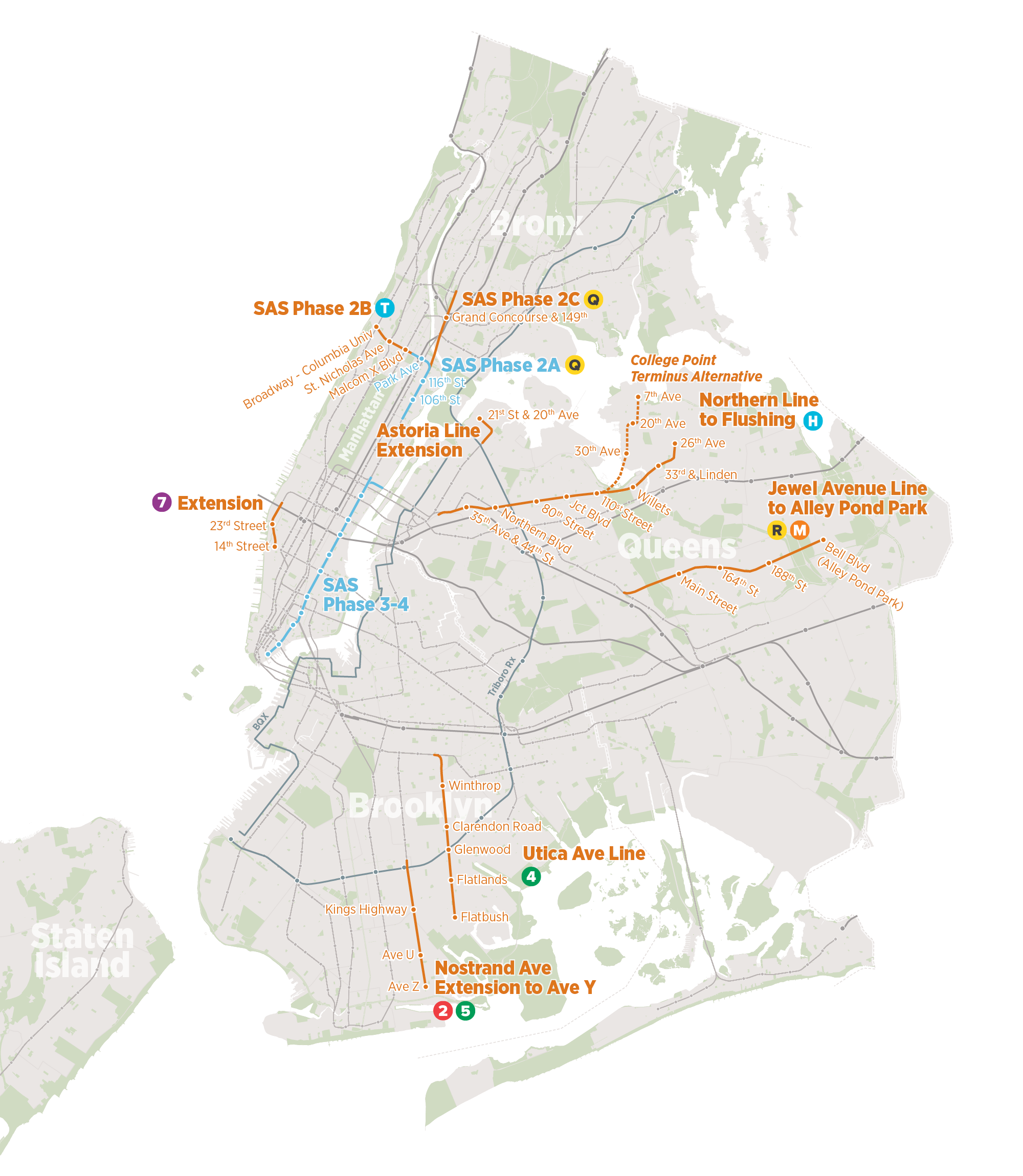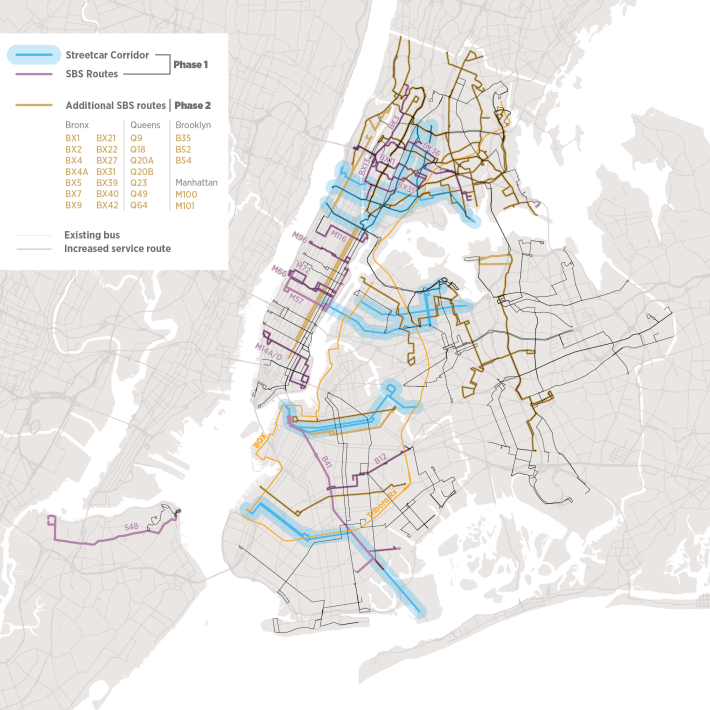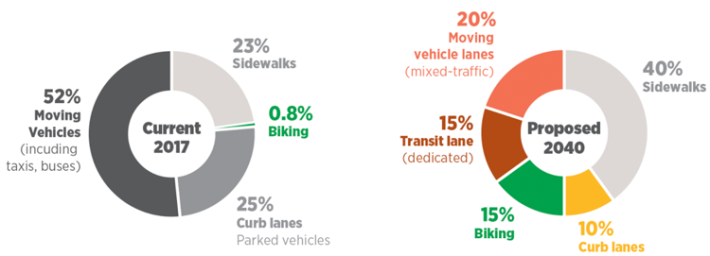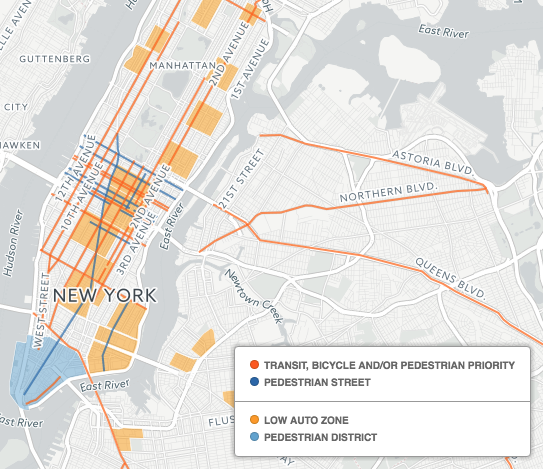This morning the Regional Plan Association released its fourth regional plan, an aspirational blueprint for steering greater New York's growth until 2040. The document, which is available in full online, contains 60 major proposals to shape infrastructure and development, with a core focus on the region's transit network and how it can support housing and jobs.
There are essentially two phases to RPA's transit vision: bringing the existing system up to snuff, and expanding it to handle the demands of a growing population.
Today, subway service is deteriorating and bus ridership is falling precipitously. RPA has a 15-year plan to fix and modernize the subways while laying out a long-term vision to build out urban transit lines and the regional rail network. These transit investments are foundational to enable environmentally sustainable growth in the New York region, with an affordable housing stock that provides access to employment for people of all economic means.
"[Transportation policy] should all be about making the system as seamless and integrated, as friendly to the customer as possible," RPA President Tom Wright told reporters at a briefing on Monday. "And we just don't have that kind of mentality."
Congestion pricing is a cornerstone of the effort, both to raise money for transit and to open up street space for more efficient uses. "We don't manage the streets," Wright said. "We want to try to move to a new paradigm on this."
It's impossible to summarize the full plan in one post but here are the major highlights for transit and streets in RPA's fourth regional plan. The ideas are big and bold, but they hinge on the basics of better governance and project delivery.
A State Corporation to Fix the Subways
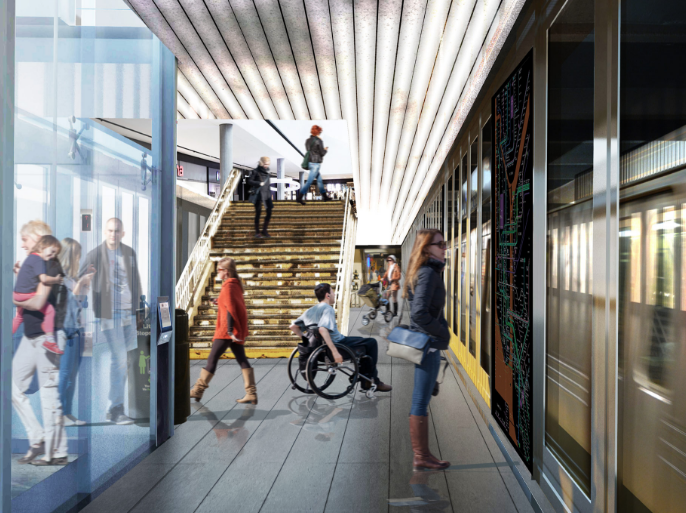
To dig the subway system out of its rut, RPA proposes a "subway reconstruction public benefit corporation" devoted to rebuilding and modernizing the entire system within 15 years. RPA thinks the MTA is not structured to see reconstruction through in a timely manner because political accountability is too indirect, and subway maintenance and upgrades are not as high a priority as they should be.
The corporation would have its own board of directors, and be under the control of the governor of New York. The new entity would be "first-among-equals... within the MTA," said Wright, "which is not what MTA Capital Construction currently has. Our idea is... give it the special powers to cut through the red tape -- to expedite, to do public-private partnerships and renegotiate labor contracts."
The subway reconstruction corporation would be charged with expediting construction and procurement, and delivering projects cost-effectively. By speeding up implementation and lowering costs, the MTA would be able to modernize signals and rolling stock, retrofit the system for full ADA accessibility, upgrade stations with platform doors, and expand capacity at the system's most crowded stations without making New Yorkers wait a lifetime.
Expansion Alongside Repair
Simply rebuilding the existing transit system won't meet the needs of a growing population. "I would argue that a system that's nicely maintained, but is too small for the region doesn't work for us," Wright said. "You have to do both."
There's a strong emphasis on regional rail and creating an integrated network with through-running service, enabling, for instance, New Jersey residents to easily get to jobs in Queens and Long Island. RPA sees the Gateway tunnel under the Hudson River, currently in the planning phase, as the starting point. More transit tunnels across the Hudson and the East River would need to be built to complete the vision.

"The growth of the region is still going to be limited by our transit capacity and the Hudson River," Wright said. "We have to be more on a planning cycle of not waiting until we're about a minute away from catastrophe before we start to plan for the next increase of capacity."
RPA also maps out potential locations for subway expansion, including a Utica Avenue line and Nostrand Avenue extension in Brooklyn, Northern Boulevard and Jewel Avenue lines in Queens, and a full Second Avenue Subway, including spurs to the South Bronx and under 125th Street.
On other major transit corridors, RPA maps out routes for bus priority upgrades and surface rail:
Using Regional Rail to Make Housing More Affordable
RPA surveyed the region's 328 commuter rail stations and found that of the 264 with sewage infrastructure to support dense development, just 43 percent allow construction of multi-family housing four stories or higher. If those zoning regulations are eased, RPA thinks the region can build housing near rail stations for 600,000 people.
With no regional entity to coordinate housing policy, getting those reforms through will be a "retail challenge," Wright said, but RPA thinks individual townships and cities will warm to downtown redevelopment.
On NYC Streets, People Come First, Not Cars
RPA anticipates that "the shared public street space is likely to change more dramatically than any other part of the urban environment over the next few decades."
RPA envisions streets where most space has been transferred from private cars to walking, biking, and transit. At present, about 25 percent of NYC street space is devoted to walking and biking. By 2040, RPA wants to see that number at 55 percent, with another 15 percent for dedicated transit lanes.
In the densest neighborhoods, RPA calls for car-free or car-lite zones, plus a network of car-free streets in Manhattan below 60th Street.
To get there, RPA says the city will need to put a price on all curbside parking, bring affordable bike-share throughout the city, and create a better network of bicycle-priority streets.
